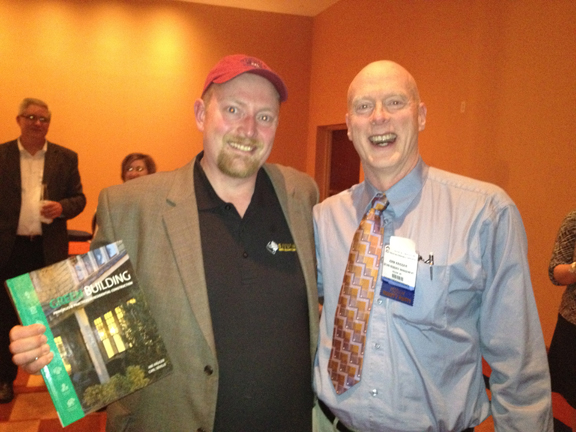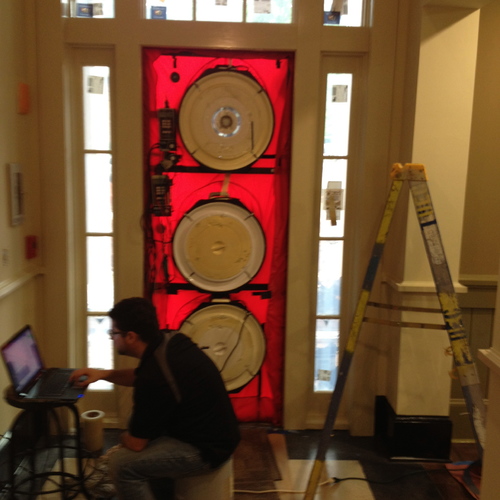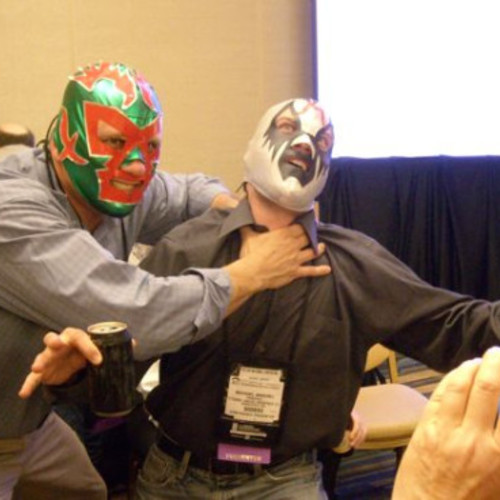The 2012 ACI National Home Performance Conference was held in Baltimore at the end of March, and was yet again another marathon geekfest. With almost twenty concurrent sessions running from 8 a.m. to 5 p.m., followed by more sessions lasting until 8 p.m., it is a feat of endurance to attend this almost week-long event.
This year there appeared to be an underground movement (Twitter handle: #ACIafterdark) that threw late-night parties, although I never managed to figure out where they were.
Heat-pump water heaters
I managed to attend several good sessions this year, providing good data and food for thought. The first panel I attended covered heat-pump water heaters, and what I learned reinforced my position that they aren’t the great hope of energy conservation that many people believe them to be.
Presenters shared results from two studies, both showing only very modest energy savings over traditional heaters. As is the case with most things, the total savings depend on many factors including where they are located in the house, use patterns, and the available free air for the heat pump to take heat from. Tests showed most units to be in the range of 10% to 40% more efficient than electric resistant heat.
High volume use maxes out the efficient heat pump mode, requiring the use of resistance heat to make up the difference, lowering efficiencies even more. These studies did not address the energy penalty that they may impose in cold climates where they remove heat from the air which offsets some of the total energy savings.
John Straube is quotable
John Straube was, as Allison Bailes put it, “a walking quote machine.”
In his presentation on insulating and air sealing roofs and attics, he was, as always funny, entertaining, and informative. One obvious, but often overlooked, point is that air sealing on new homes frequently leaks in short order as new framing lumber shrinks and creates gaps, while air sealing on retrofits lasts much longer since the lumber is more stable. In real terms, a typical 1/16” crack between drywall and top plates adds up to 12 square inches for each 100 feet of wall.
My favorite Straube quote of the day: “R-Value is like IQ — when you’re in single digits, you’re kind of an idiot.” In an extended discussion comparing deep-energy retrofits to minor repairs, he referred to the latter as “turd polishing,” pointing out that you can’t always afford the expensive stuff, and if you are “surrounded by turds, it’s nice if they’re shiny.” Can’t wait to see him again.
Some geeks are studying marketing
There were almost continuous sessions on marketing, websites, and blogging, and all appeared to be well attended. The geeks have realized that they need to market, and they (we?) were happily taking notes and tweeting away throughout the sessions.
Probably my favorite event was an evening session hosted by Chris Dorsi that was delivered entirely in the Pecha Kucha format that restricts each presenter to 20 slides and 20 seconds per slide. I was impressed at the quality of the speakers and their ability to get their information across quickly and concisely.
Book raffle
On Wednesday evening, Dow Building Solutions hosted a party for our new book, raffling off several copies to the group. Three different people with Habitat won copies, but my favorite photo of the night was John Krigger, co-author of Residential Energy posing with his associate Darrel Tenter and our book. I returned the favor the next day by posing with his.
Overall, the conference was very good, and not noticeably different from previous years. I still contend that there are too many sessions and they go on too long. Maybe they should just give up all pretension and switch to a 24-hour conference. If you want to be in a session at 8 p.m., why not one at 3 a.m.?
There are still too many presenters who don’t know how to put together a readable, visually compelling presentation, and too many are simply not good speakers. As with most conferences, I would like to see better vetting of speakers, something that should happen as videos of speakers become more commonplace.
Although I returned home thoroughly exhausted from the experience, ACI was well worth the effort and I expect to return again.
Weekly Newsletter
Get building science and energy efficiency advice, plus special offers, in your inbox.
















6 Comments
Well who'da thought it?
You mean if it comes in a big cardboard box with 'green' written all over it it ain't necessarily so? What a surprise.
Heat Pump Water Heaters
While I agree that HPWH may be a zero sum game, robbing Peter to pay Paul, in heating dominated climates, they are an absolute no-brainer in the south where we have tens of millions of storage electric water heaters in warm humid garages.
Response to Curt
Carl specifically indicates that efficiency improvements are much lower than claimed even before the heating climate energy penalty:
"High volume use maxes out the efficient heat pump mode, requiring the use of resistance heat to make up the difference, lowering efficiencies even more. These studies did not address the energy penalty that they may impose in cold climates where they remove heat from the air which offsets some of the total energy savings."
There seems to be a Catch-22 with this technology: high volume use kicks in the resistance heater more often, while low volume use extends the ROI beyond the useful life of the unit. ROI isn't everything, but you might ask where the extra cost of the HPWH might be better spent on more effective improvements. This technology has promise, and even some useful applications right now, but consideration of opportunity cost makes it anything but a no-brainer.
Response to James
I'm looking forward to seeing those studies. My own 2-3 year experience with an add-on HPWH (an early model Geyser) is that it cut our water heating cost by 50% over resistance while also providing useful cooling and dehumidification in my basement mechanical room. My 50% energy consumption finding is supported by long time submetering, not a mere guess.
Downside is that it is a somewhat noisy "Frankensystem", dubiously ready for prime time.
I'm told Geysers have been improved, but the drop in cost of integrated HPWH has caused me to install a couple in recent "wide energy retrofit" client homes. They've been well received. I lock them in E mode such that they won't fire the resistance element unless ambient drops below 45*F, a rare condition in a Jacksonville, Fla. garage. Clients understand the longer recovery time - in fact some like the idea of finite hot water driving a child OUT of the shower
A lengthy test by Advanced Energy on a GE HPWH deliberately installed in a substandard location revealed its robustness as well as a substantial increase in EF when setpoint is dialed down from 135 (DOE test temperature) to a safer 120.
Prior to installing the HPWH I clocked client's existing resistance heaters using hourmeters on each element. That clocking yields both accurate, client specific energy use and cost for an accurate payback time forecast as well as an indication of how often they come close to running the tank out (upper element time)
I have a client under clocking test this week, and my plan is to install a 60 gallon (the non-GE unit sold under about 10 brand names) and then hang a TED energy monitor on it to acquire before and after cost data.
Meanwhile, GE has revamped their 50 gallon model, supposedly making it more installer and user friendly as well as bumping EF to 2.4. I'm told they plan an 80 gallon model for the fall.
The answer to the backup resistance element is to ensure HPWH is sized to minimize those incidents.
I'll report my before and after energy usage for the 60 gallon HPWH candidate client if there is still interest here
I hope the ACI presenters study data becomes available soon.
Feeback from one of the ACI presenters on HPWHs
The average, measured COP from our study was more than twice the EF of typical electric resistance water heaters; this basically means that – on average – water heating costs were half what they would have been with ERWHs. Though there was a wide range in COPs. This was due to older tanks being swapped out with similar sized HPWHs, which is not appropriate. If properly sized (the methodolgy is different than for a standard electric resitance tank) and installed in suitable locations, a HPWH provides significant savings over a standard electric resistance water heater. There are interactions with the space conditioning system that need to be accounted for when evaluating the overall benefit of this equipment (make-up space heat, added cooling/dehumidification). Still, when accounting for all these parameters, a HPWH is a viable technology with a promising future (as long as people follow some basic rules) in nearly all climate zones. For more information, refer to http://apps1.eere.energy.gov/buildings/publications/pdfs/building_america/measure_guide_hpwh.pdf
Thanks for the feedback
Curt - good to hear that your HPWH are performing well.
Srikanth - thanks for chiming in. I appreciate your points that people have to follow basic rules in order for them to work to their highest efficiency. Unfortunately, most people don't pay attention to the details, purchase equipment that is touted as the new "thing", stick it in and never get the results they should. I agree that HPWH have potential, but they are being promoted by manufacturers as being the best solution under all conditions (Like all people selling things tend to do) when the answer is much more complex. Like most things in high performance green building, there is rarely a single right answer to any question, the most accurate answer is "it depends"
Log in or create an account to post a comment.
Sign up Log in